We are strangers even to ourselves.
This seems to be the message of “Souvenirs,Brooklyn-based artist Eunnam Hong’s New York debut can now be seen at Lubov NYC, leaving a lingering aftertaste of unease in viewers as the familiar surroundings feel subtly changed, filled with desires hidden and latent potentials.
Hong herself is the model for each of the subjects – or “characters” as she calls them – in the 10 acrylic-on-linen works featured in the exhibition. Sometimes she stands alone in the scene or is paired up, and in one instance she appears as a set of five figures each carrying a handkerchief.
Although the artist is recognizable in these paintings, the works are not self-portraits in the traditional sense. Instead, Hong appears in exaggerated, almost awkward poses, donning costumes that look like they’re pulled from avant-garde director Wong Kar-wai’s films or the glossy pages of fashion magazines. Opulent wigs with platinum or brown curls sit on her head in almost every painting, taking on the appearance of characters in their own right, an octopus of hair, almost.
Hong paints in a studio in his Park Slope home, and a familiar eye will recognize some of the architectural attributes of the neighborhood’s brownstones – antebellum moldings, high ceilings, socket covers thick with layers of paint. Looking from paint to paint, one can begin to get a sense of a space, filled with mid-century furniture, that feels real, concrete, and personal, if not completely cohesive.
The female figures positioned on the canvases however feel decidedly more illusory, creations of the imagination.
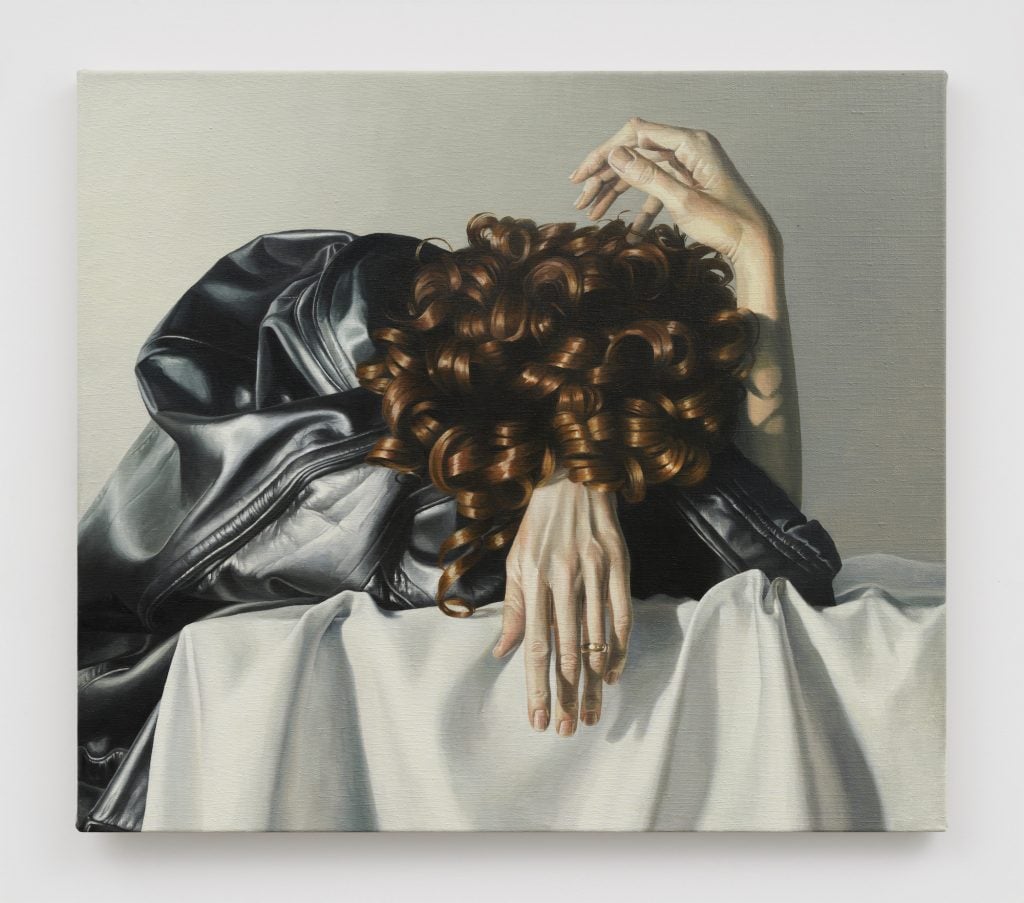
Eunnam Hong, Myth (2023).
Over the past two years, these singular and provocative images have sparked the interest of art world insiders and collectors. But the rise in the art world has not been easy for Hong.
Born in Gangwon-do, South Korea, Hong dreamed of studying painting, but her parents pushed her towards more practical possibilities. eventually, she studied graphic arts at the prestigious Seoul Institute of the Arts, as an internal compromise.
After college, she embarked on a career as an art director, often working in the fashion world and taking on projects with industry leaders like Edward Enniful. In these positions, Hong honed her eye for material culture, developing a precise familiarity with fashion and, perhaps most importantly, learning the possibilities of representation behind the camera.
After nearly a decade working in this industry, Hong was still keen to pursue painting and she moved to New York in 2006 for what was to be a year-long sabbatical. Her paintings from this time delve into contemporary plastic surgery, and while she seriously pursued these works, they left her somewhat unsatisfied.
Life, with all its unexpected complexity, also hijacked his plans. Hong met an American, now her husband, and the sabbatical turned into a permanent move. Then she gave birth to her son, who is now nine years old.
For Hong, these new roles – wife and mother – were a seismic reconsideration of self, and she began to struggle with her own identity and the idea of multiples. A moment of transcendence occurred a few years ago when Hong, on a lark, got behind a camera and then in front of it, capturing footage of herself. The disconnect she felt with the person in the photos opened up a space for her to consider all that she may not have known about herself, and the ways in which, as an Asian artist who moved in the United States as an adult, she might be seen as “other”, in a way that she doesn’t see herself.
“The lens has a different way of looking at things,” Hong said in a conversation in Lubov. “I thought I knew who I was and what I looked like, but the photographs delivered a completely different picture of myself. It was quite fascinating to me. Photographing oneself in costume became a starting point for constructing paintings exploring complex and contradictory emotions.
“These characters come from my inner world. I have thought a lot about the home environment and my life over the past decade,” Hong explained. “There are psychological uniforms that I’ve worn over the years – as an artist, mother, wife – in relation to the outside world. I wonder how it shapes my relationship with myself and certain things I do or don’t do.
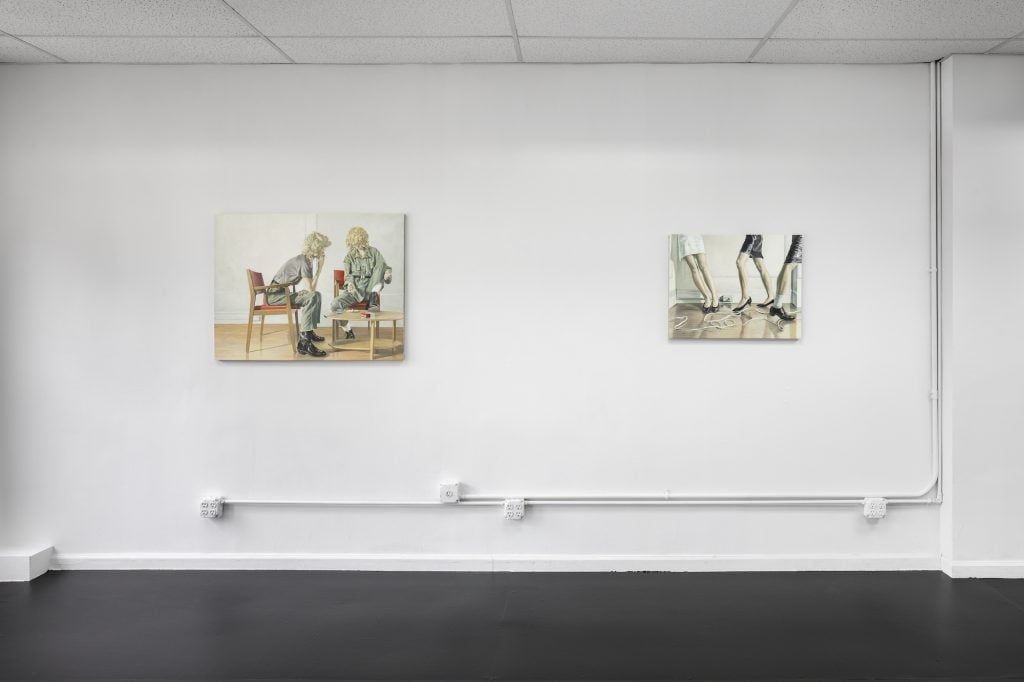
Installation view ‘Eunnam Hong: Memories’, 2023. Courtesy of Lubov NYC.
To construct her paintings, Hong works early in the morning, first sketching out ideas of what she wants to convey. Then she starts taking pictures of herself from different angles and sets. She sources her clothes from vintage shops and online. These sets are more than stage sets; these are the very memories to which the title of the exhibition refers. “Clothes are a very collective experience,” Hong said. “We all participate in fashion in our own way.”
Souvenirs are kept to commemorate travels, but also for their talismanic ability to awaken memory – the word itself derives from the French meaning ‘to remember’ or ‘to come to mind’. In Hong’s artful compositions, attire can evoke an entire era.
In the painting Jean jacket (2023), for example, an androgynous figure dressed in blue jeans appears several times: lying on a bed, kneeling, leaning against a door. The painting is reminiscent of the posh editorials of the 1990s. What Hong offers us is not nostalgia or comedy, but a provocative, private and eerie image. The characters seem to be trapped waiting for the story to continue, for someone to open the door. The memory of the denim jacket maybe belonging to a lover, maybe, waiting somewhere beyond the canvas, or maybe still, a memory of a younger self.
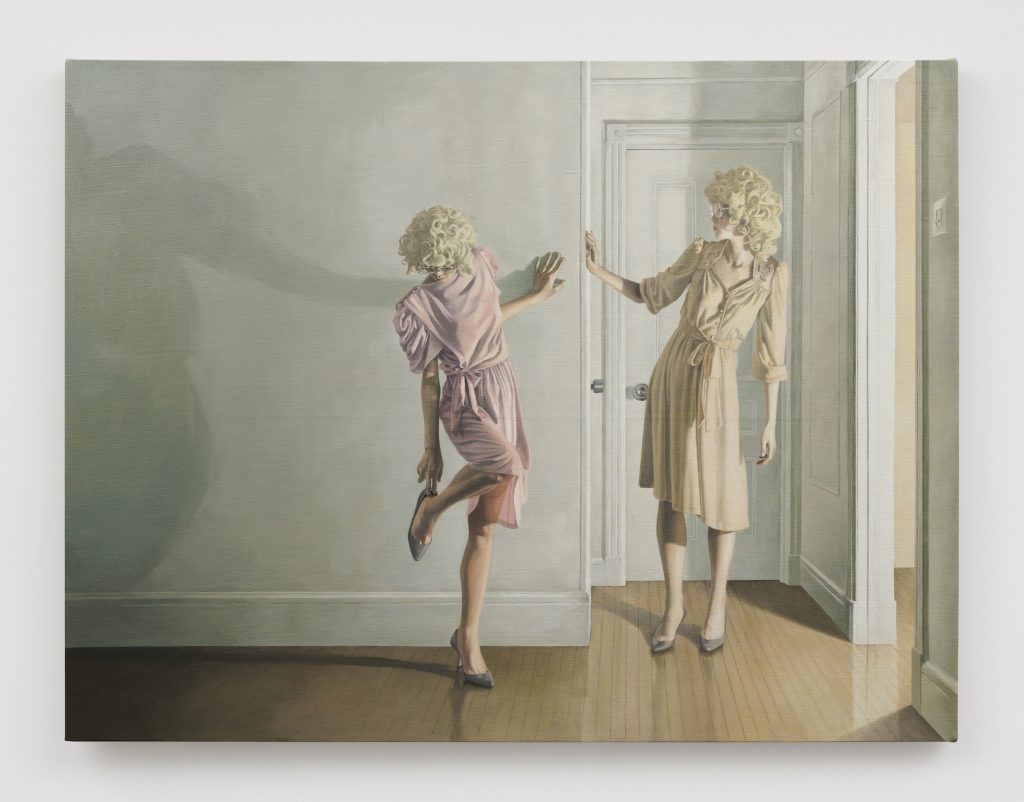
Eunnam Hong, Dresses (2022). Courtesy of Lubov NYC.
In another book, Dresses (2022), two identical blonde women, painted with an unreal alabaster whiteness, lean against the walls of the entrance to an apartment, dressed in dresses – one beige and the other the palest pink – which set the scene in the late 1970s or early 80s. The women, again, seem to be waiting, claustrophobically trapped as they keep company only to themselves, their own thoughts and to their own timeline.
Talking to Hong, I mention a confluence with Vermeer – the staging, the light pouring in from specific angles, and the repeated use of the same clothes as props for the models, all resemble the Dutch master. Vermeer has often been praised for his proto-cinematic style, and Hopper – to whom Hong has also earned comparisons – for his influence on filmmakers. But Hong says she’s more influenced by the films themselves than the canons of art history. Growing up in Gangwon-do, a city without a strong visual arts culture, Hong says movies were her main mode of consuming avant-garde culture.
In this light, the blonde wigs that dominate his paintings take on new meanings. Wong Kar-wai’s film Chung King Express (1994) and the enigmatic character of “The Woman with the Blonde Wig” played by Taiwanese actress Brigitte Lin immediately come to mind. Wong’s cinema, famous for its non-sequential narration, also offers new possibilities for approaching Hong’s works. Time and events are confused and flattened, as in a medieval painting. Everything happens at once, and also distinctly.
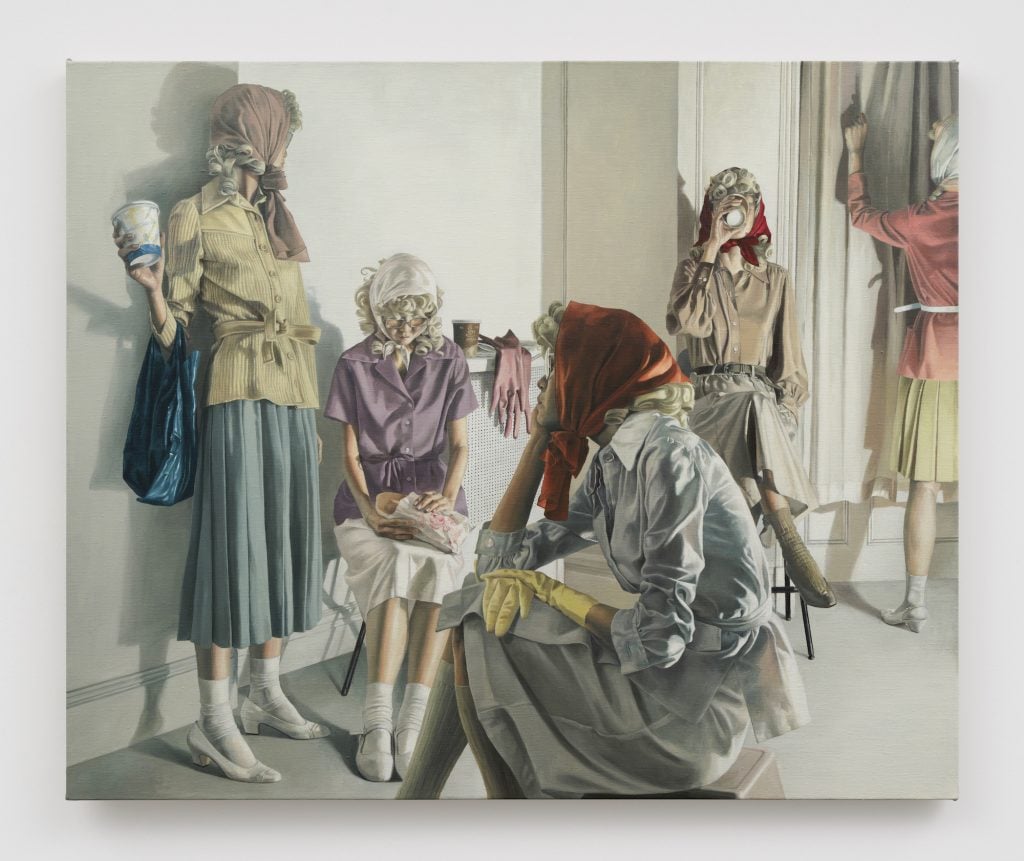
Eunnam Hong, Lunch time (2023). Courtesy of Lubov NYC.
Director John Cassavetes is another influence. Hong says she is interested in what it means to grow old as a woman and the roles we are asked to fill. “Gena Rowlands” is an example that we both cite at the same time, and there is a clear similarity between Hong’s paintings and the actress’ appearance in her husband’s films, especially A woman under the influence (1974), which was the title of Hong’s first solo exhibition at boer’s gallery in Los Angeles in 2022. The film follows a working-class man and his attempts to maintain some semblance of normality in a household where his wife , performed by Rolands, descends deeper and deeper into a nervous breakdown.
“Rowland’s characters are both completely relatable and very dark,” Hong said. “I turned a corner, especially when I had my child, when I realized that I was living in these layers of roles – my new identity as a mother or a wife. It was distressing and I came to a point where it shattered my notion of my individualism as an artist. This idea of, “This is who I am, with heart and passion,” she explained, “I was shaken but also attracted by these unpleasant feelings.”
Another cinematic comparison that comes to mind when looking at Hong’s paintings are Rainer Werner Fassbinder’s female protagonists, in films such as The bitter tears of Petra von Kant (1972) or Marriage of Maria Braun (1978), centered on complex loves. “These characters allow me to act out the feelings that I’m trying to name,” Hong said.
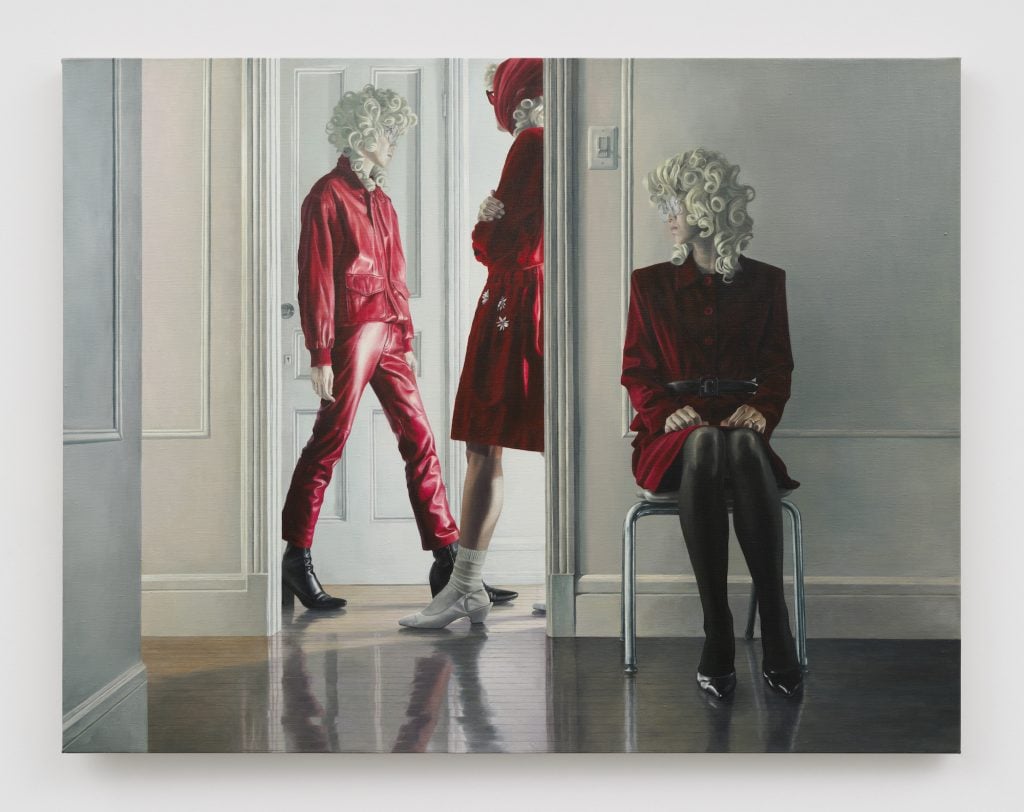
Eunnam Hong, Enemy (2023). Courtesy of Lubov NYC.
Hong’s paintings, like these films, explore the roles of women inside and outside the home. For Hong, working inside the home as a painter has made her wonder what the job is really like. “Being an artist is an ambiguous identity – you are very sure of what you are doing, but you can also feel very isolated. It’s hard to situate yourself in terms of work and toil,” she says.
His painting Lunch Break features the character of a woman enjoying some downtime in five vignettes. There is no shortage of takeaway coffee mugs and scarves. For Hong, the image evokes Hong Kong, the Asian food stalls and takeaways she is nostalgic for. But the images also speak of the lives we imagine for ourselves, for other selves that might have been.
In the strange sci-fi painting, Enemy (2023), for example, three figures appear entirely dressed in purple. A figure sits in a chair in a darkened room, perhaps unaware of these other versions of herself in the lit room behind her. The painting is taut with a sense of conspiracy. These other selves, Hong seems to be saying, may still exist and are not necessarily on our side.
“There is this enemy, a kind of double me, who always pushes me or puts pressure on me. It’s a constant battle going on between my ears in my head,” Hong explained. “We all have these other identities and sometimes I really think they’re trying to replace us.”
“Eunnam Hong: Memories” runs at Lubov NYC, 5 East Broadway, #402, New York, through June 18.
Follow Artnet News on Facebook:
Want to stay one step ahead of the art world? Subscribe to our newsletter to receive breaking news, revealing interviews and incisive reviews that move the conversation forward.
